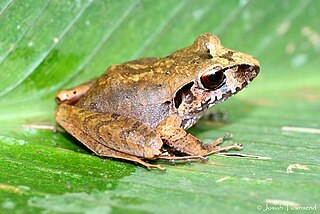
The broad-headed skink or broadhead skink is species of lizard, endemic to the southeastern United States. The broadhead skink occurs in sympatry with the five-lined skink and Southeastern five-lined skink in forest of the Southeastern United States. All three species are phenotypically similar throughout much of their development and were considered a single species prior to the mid-1930s.
The broad-headed spiny rat is a spiny rat species from South America. The etymology of the species name is the Latin word laticeps meaning "wide-headed".
Hylaeamys laticeps, also known as the Atlantic Forest oryzomys or the large-headed rice rat, is a species of rodent in the family Cricetidae.

The Australian swellshark or draughtboard shark, is a species of catshark, and part of the family Scyliorhinidae, endemic to southern Australia. This bottom-dwelling species can be found on the continental shelf down to a depth of 220 m (720 ft). Usually measuring 1 m long, it is a stout-bodied, broad-headed shark with a short tail and a first dorsal fin much larger than the second. It can be identified by its variegated dorsal coloration of brown or grey patches and numerous spots.
Hyperolius laticeps is a species of frog in the family Hyperoliidae. It is endemic to Togo. Its natural habitats are rivers, swamps, freshwater marshes, and intermittent freshwater marshes.

Craugastor laticeps is a species of frog in the family Craugastoridae. It is found in Belize, Guatemala, Honduras, and southern Mexico.

Proceratophrys laticeps is a species of frog in the family Odontophrynidae. It is endemic to Brazil. Its natural habitats are subtropical or tropical moist lowland forest and rivers. It is threatened by habitat loss.
Telmatobius laticeps is a species of frog in the family Telmatobiidae. It is endemic to Argentina. Its natural habitat is rivers. It is threatened by habitat loss.

Aglyptodactylus laticeps is a species of frog in the family Mantellidae. It is endemic to Madagascar. Its natural habitats are subtropical or tropical dry forests and intermittent freshwater marshes. It is threatened by habitat loss.
Taeniolethrinops laticeps is a species of cichlid endemic to Lake Malawi where it occurs over sandy substrates. This species can reach a length of 30 centimetres (12 in) TL. it was discovered by Ethelwynn Trewavas.

Nectophrynoides laticeps is a species of toad in the family Bufonidae. It is endemic to the Ukaguru Mountains of Tanzania. Common name wide-headed viviparous toad has been proposed for it.
Hylaeamys oniscus, the sowbug rice rat, is a rodent species in the family Cricetidae. It was formerly placed in the genus Oryzomys as Oryzomys oniscus.

The big-head schizothoracin is a species of freshwater ray-finned fish belonging to the family Cyprinidae, the family which includes the carps, barbs and related fishes. It is the only member of the genus Aspiorhynchus, which is classified within the subfamily Schizothoracinae, the snow barbels. This species is endemic to Xinjiang, where it was found only in stagnant lakes and slow flowing rivers in the basin of the Tarim He. The only nown extant population is in the Kezier Reservoir, a population maintained by the introduction of captive bred fish. The big-head schizothracin is a predatory species which feeds on other cyprinids and Triplophysa loaches. It migrates into smaller, bouder strewn alluvial fan streams to spawn.

Enyalioides laticeps, the Amazon broad-headed wood lizard, is a dwarf iguanian lizard abundantly found in Amazonian rainforests. They are semi-arboreal and mostly live in forests. Other names for it include broad-headed wood lizards, Big-headed stick lizards, Guichenot's Dwarf Iguana, Amazon Forest Dragon, or Amazon Dwarf-Iguana.

Chrysoblephus laticeps, the red roman or roman seabream, is a species of marine ray-finned fish belonging to the family Sparidae, the seabreams and porgies. This fish is endemic to Southern Africa, ranging from Namibia to the Eastern Cape.
Mattauschia is an extinct genus of trematopid temnospondyls from the Late Carboniferous of the Czech Republic.

Pedioplanis laticeps, known commonly as the Cape sand lizard or the Karoo sand lizard, is a species of lizard in the family Lacertidae. The species is endemic to Southern Africa.
Sitana laticeps, the broad-headed fan-throated lizard, is a species of agamid lizard. It is endemic to India.
Cataetyx laticeps is a species of fish in the family Bythitidae.
Chelonodontops laticeps, also known as the bluespotted blaasop, is a species of pufferfish in the family Tetraodontidae. It is native to the western Indian Ocean on the coast of Africa, from South Africa north to Tanzania, and around Madagascar. FishBase includes also Papua New Guinea in its range.










